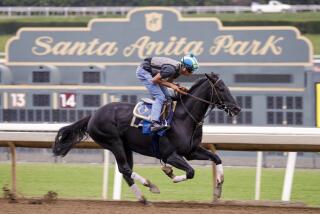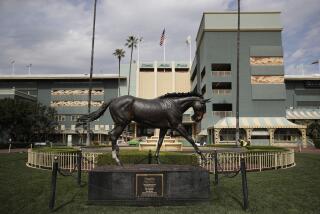Santa Anita leads California tracks in horse racing deaths
Horses died while racing at Santa Anita Park at more than double the rate of horses at the state’s other three major thoroughbred tracks over the last fiscal year, according to state statistics.
The fatality rate at Santa Anita, in Arcadia, rose significantly after a return to a dirt running surface in 2010 after three years of using a synthetic track, the data show.
Track surfaces are one of several factors that experts say play a role in horses’ deaths — a longtime bane of the racing industry. A consensus is emerging among researchers that synthetic surfaces are safer than dirt for racing, though it is unclear whether the same is true for training. Training regimens, racing schedules, breeding practices and the use of medications are also thought to be important variables.
The deaths of three horses during the production of the television horse racing drama “Luck” — which happened to be made at Santa Anita — has drawn recent attention to the issue. HBO canceled the series this month after the third incident in which a horse on the set suffered injuries and had to be euthanized.
Yet as racing fans everywhere know, it is not uncommon for horses to break bones during races and later receive a lethal injection. At tracks across California, 186 horses died after racing and training accidents during the last fiscal year, according to statistics from the state horse racing board. An additional 79 horses died at tracks from other causes, including intestinal and respiratory diseases.
At one New York track — Aqueduct — 20 horses have died since Nov. 30. The governor ordered an investigation this month.
Even under the best circumstances, fatalities in horse racing may be as inevitable as concussions in football.
Barry Abrams, a racehorse trainer in Southern California for three decades, said he is deeply troubled by every death but that it is unrealistic to think that fatalities can be eliminated. Certain types of fractures are extremely difficult to treat because horses cannot lie down for long periods without risking respiratory illness and other health problems. Euthanizing them is considered the most humane option.
“The race horses are born to race,” Abrams said. “That’s why people breed them. Nobody wants them to die.”
Horse racing is losing popularity to other forms of gambling, and the number of races and race horses has been declining. The industry, though, has faced increasing scrutiny as a result of high-profile cases such as that of Barbaro, who two weeks after winning the 2006 Kentucky Derby, shattered his right hind leg in the Preakness Stakes. After several operations failed, he was euthanized.
Susan Stover, a professor of veterinary medicine at UC Davis who examines the broken bones of deceased California race horses, said that fatal injuries usually start as mild ones that went undetected.
“We need to be able to pick up those minor injuries,” Stover said.
Her research team studies the forces placed on bones, tendons and joints when horses run — information that she hopes will help develop track surfaces with the optimal balance of cushioning and support.
Until the last decade, there were two main types of tracks in the United States: dirt and grass. But in 2006, the California Horse Racing Board gave the state’s major thoroughbred tracks two years to replace their dirt tracks with surfaces that include polymers, wax and other synthetic materials. A track in Kentucky had changed to synthetic materials and dramatically cut deaths during races.
California saw similar results. Rick Arthur, the equine medical director for the state racing board, studied racing deaths at the four tracks between 2004 and 2009 and found that fatalities per 1,000 racing starts fell from 3.09 on dirt to 1.95 on synthetic — a 37% reduction. (Each time a horse begins a race counts as one “start.”) “The numbers speak for themselves,” Arthur said.
A 2010 study of death statistics from nearly 90 tracks throughout North America found that over a two-year period, the number of fatalities per 1,000 starts was 1.55 on synthetic surfaces, compared with 2.14 on dirt. But most U.S. tracks remain dirt. It’s tradition. Also, many gamblers believe synthetic tracks minimize the differences among horses, making it harder to predict the winners. And for an industry struggling economically, the cost of switching surfaces is enormous.
Many trainers in California and elsewhere say that synthetic surfaces lead to more soft-tissue, hind-leg injuries. They also say that the fatality rates seem to be higher on synthetic surfaces during training, possibly because training takes place in the mornings and the properties of a synthetic track may change with temperature and humidity. The state horse racing board is gathering data to analyze the training risks.
Synthetic surfaces can be more difficult to maintain than dirt. But the new $11-million track at Santa Anita was particularly troublesome.
By the spring of 2010, the drainage system had failed, and attempts to fix the problem only made things worse. When rocks began to poke through the surface, the trainers threatened a boycott and the track owners announced that they were giving up on synthetics.
The state horse racing board granted Santa Anita an exemption, and the track was reconverted to dirt.
In three years of running on a synthetic track, there were 26 racing deaths, or 1.5 fatalities per 1,000 starts. In the last fiscal year, after the change back to dirt, there were 12 fatalities, or 3.7 per 1,000 starts, according to data from the state horse racing board.
By comparison, a total of 28 horses died last fiscal year racing on the synthetic surfaces at the three other major thoroughbred tracks — Del Mar Racetrack, Golden Gate Fields and Hollywood Park — at a rate of 1.8 fatalities per 1,000 starts.
(All four race facilities also have grass tracks, which are used less frequently and have had a small effect on the overall rates of racing deaths.)
Officials from Santa Anita and the state horse racing board said they had little choice but to heed the wishes of the horse trainers. “It was overwhelming that they wanted to return to a dirt surface,” said George Haines, the Santa Anita president.
He said the track owners remain committed to improving the dirt surface. After the high death rate last season, Santa Anita spent nearly $1 million to modify the composition of the top six inches. Statistics for the current race season were not available.
“It’s really a science,” Haines said. “We monitor the track constantly”
California in many ways is far ahead of other states in trying to improve safety in horse racing. For the last two decades, it has contracted with UC Davis to conduct necropsies on every horse that dies at a track. Most states do not even require tracks to make their statistics available to the public, and few do on their own.
Pasadena resident Connie Cousins used to visit Santa Anita at sunrise to admire the horses as they trained. After some of her favorites failed to show up, she learned that they had been euthanized following accidents. In 2005, she started an online “memorial wall” to honor them and others.
“Remembering the valiant horses who have perished in service to the Sport of Kings,” she says on her website, which now cites more than 1,800 deaths around the world over the last six years. Her list is far from complete.
“As long as they are racing, this is going to happen,” said Cousins, adding that she can’t bring herself to attend races anymore.
More to Read
Sign up for Essential California
The most important California stories and recommendations in your inbox every morning.
You may occasionally receive promotional content from the Los Angeles Times.











